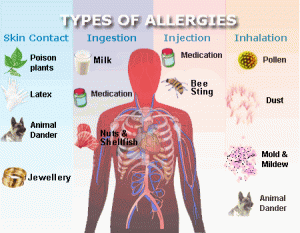

[vc_row][vc_column width=”2/3″ css=”.vc_custom_1552633559502{padding-bottom: 40px !important;}”][vc_column_text]
 An allergy is an overly sensitive (hypersensitive) disorder of immune system. If you are allergic,
An allergy is an overly sensitive (hypersensitive) disorder of immune system. If you are allergic,
your immune system responds to your triggers in an abnormal way
These triggers are called allergen or antigen. Antigens include pollen, dust mites, mold spores,
pet dander, food, insect stings, and medicines.
[/vc_column_text][vc_empty_space height=”25px”][vc_column_text]
Allergens enter your body by four different routes:
[/vc_column_text][/vc_column][vc_column width=”1/3″][vc_widget_sidebar sidebar_id=”allergies-menu” el_class=”service-submenu”][/vc_column][/vc_row][vc_row][vc_column width=”2/3″ css=”.vc_custom_1552633521603{padding-bottom: 20px !important;}”][vc_column_text]
Allergic Rhinitis
Allergic rhinitis (“hay fever”) is the most common of the allergic disease. Symptoms result from the inflammation of the mucus membranes of nose, sinuses, and throat. Hay fever symptoms include
Asthma
Asthma is a breathing problem that results from the inflammation and spasm of the lung’s air passages (bronchial tubes). Common symptoms include:
Allergic Eyes
Allergic eyes (allergic conjunctivitis) is inflammation of the membranes that cover the surface of the eyeball and the inside of the eyelid. Symptoms of allergic eye include:
Allergic Eczema
Allergic eczema (atopic dermatitis) is an allergic rash due to inflammation of skin. Atopic eczema often occurs with hay fever and asthma. Symptoms include:
Hives
Hives (urticaria) are skin reactions that appear as itchy swellings on your skin. Typical hive symptoms are:
Anaphylaxis or allergic shock
Allergic shock (anaphylaxis or anaphylactic shock) is a life-threatening allergic reaction that can affect several organs at the same time. This response typically occurs when the allergen is eaten or injected. Common symptoms of anaphylaxis include:
[/vc_column_text][vc_empty_space height=”30px”][vc_column_text]
Allergy is diagnosed by history, physical examination, skin allergy test, allergy blood tests, and occasionally by deliberate allergen challenge. Allergy skin tests is the most common way to diagnose allergy.[/vc_column_text][/vc_column][/vc_row]